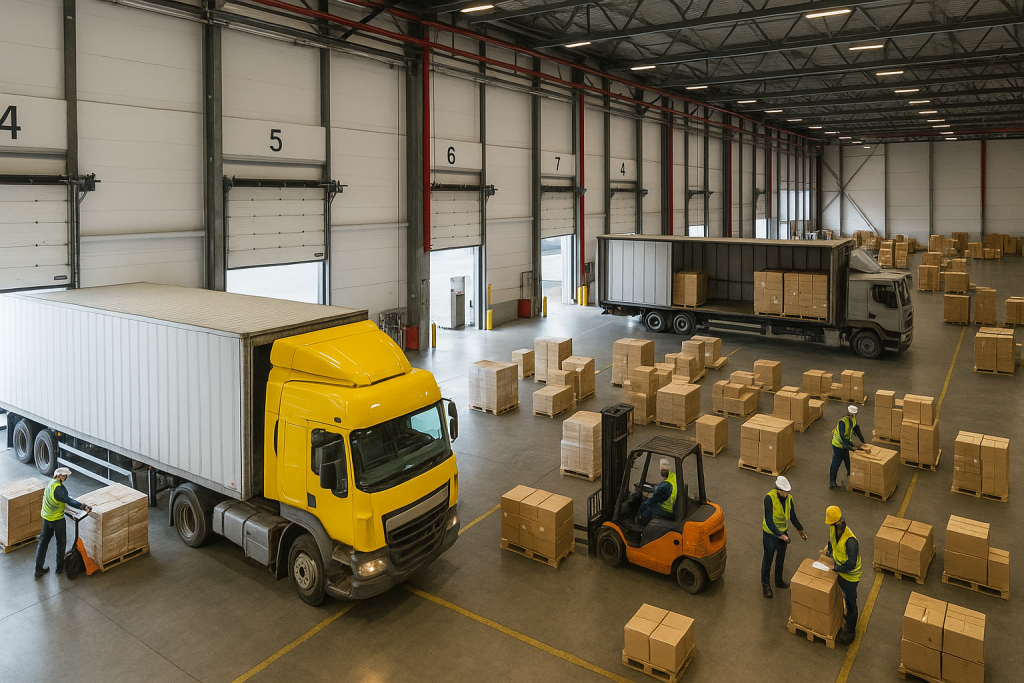By Martin Vassilev / 18 Sep, 2025
In today’s fast-moving global economy, businesses are under immense pressure to optimize their supply chains, reduce costs, and deliver faster. One strategy that has proven highly effective is cross-dock warehousing. By eliminating unnecessary storage and streamlining product flows, cross-docking helps companies achieve significant competitive advantages. This is especially true in strategic hubs like Vancouver, a gateway to Asian markets, and New Jersey, a logistics hotspot serving the U.S. East Coast.
This article explores the role of cross-dock warehousing in these two regions, its benefits for retailers, manufacturers, and e-commerce companies, and how leveraging this strategy can transform supply chains into lean, customer-centric networks.
Cross-dock warehousing is a logistics practice where products from inbound shipments are directly transferred to outbound vehicles with little or no storage in between. Unlike traditional warehousing, which focuses on holding inventory, cross-docking emphasizes speed and flow.
Inbound delivery of goods to a cross-dock facility.
Sorting and consolidation based on outbound requirements.
Immediate outbound dispatch to retail stores, customers, or distribution points.
This model eliminates extended storage costs and minimizes handling, which can dramatically improve supply chain efficiency. Companies can also integrate real-time tracking and AI-driven warehouse automation to maximize cross-dock efficiency, aligning with modern warehouse optimization practices.
Vancouver is Canada’s largest port city and a critical gateway for goods entering North America from Asia. The Port of Vancouver handles more than 147 million tonnes of cargo annually, making it a prime location for cross-dock operations.
Shorter transit times: Goods arriving from Asia can be processed quickly and redirected across Canada or into the U.S. market.
Integrated infrastructure: Access to rail, trucking, and air freight makes Vancouver a multimodal logistics powerhouse.
For businesses relying on imports, establishing a cross-dock presence in Vancouver ensures faster replenishment and reduced costs, which is essential in competitive industries like retail and e-commerce.
New Jersey is strategically located within reach of 40% of the U.S. population in just a day’s drive. Its closeness to New York City, Philadelphia, and Boston makes it a central hub for regional and national distribution.
Port of New York and New Jersey: The largest port complex on the East Coast.
Highway and rail networks: Seamless access to I-95 and other critical highways.
E-commerce growth: With major distribution centers for Amazon, Walmart, and Target, cross-docking is integral to keeping up with same-day and next-day delivery demands.
By positioning cross-dock facilities in New Jersey, businesses can ensure rapid last-mile delivery and improved customer satisfaction, a concept tied closely to smart warehousing solutions.
Cross-docking minimizes storage, allowing goods to move from inbound to outbound transport within hours. This supports same-day or next-day delivery, a critical factor in today’s retail and e-commerce landscape.
Eliminating long-term storage lowers warehouse expenses, while consolidated shipments reduce transportation costs. Businesses can also avoid hidden costs of poor warehousing such as inefficiencies and inventory losses (source).
By cutting unnecessary steps, cross-docking enables leaner supply chains. This is especially vital during global supply chain disruptions, where agility and speed become survival factors (global supply chain strategies).
Less handling means fewer opportunities for goods to be damaged. This is particularly valuable for fragile, perishable, or high-value products.
Cross-docking reduces energy consumption by minimizing storage needs and streamlining routes. It aligns with green logistics principles that modern businesses are adopting to reduce their carbon footprint (external reference: U.S. EPA on sustainable supply chains).

Large retailers rely on cross-docking to reduce inventory holding costs and ensure stores remain stocked with trending products. Retailers like Walmart pioneered cross-docking to keep shelves replenished while avoiding overstocking.
With rising customer expectations for faster shipping, e-commerce businesses benefit greatly from cross-docking. Facilities in Vancouver and New Jersey can serve as regional fulfillment nodes, supporting ultra-fast delivery promises.
While cross-docking offers immense benefits, it requires careful planning and investment.
Technology Integration – Successful operations rely on real-time tracking, AI, and automation. Solutions like AI in logistics play a crucial role.
Coordination with Suppliers – Timely inbound shipments are critical. Delays can disrupt the entire flow.
Initial Setup Costs – Establishing advanced cross-dock facilities requires capital for infrastructure and workforce training.
Limited Suitability – Cross-docking works best for high-demand, fast-moving goods; slower-moving items may still require traditional warehousing.
Companies that successfully implement cross-docking in Vancouver and New Jersey gain:
Faster market penetration in both North American and international markets.
Cost leadership through reduced warehousing and transportation expenses.
Customer loyalty with faster, more reliable delivery services.
Scalability to adjust operations based on demand surges or seasonal peaks.
For businesses evaluating their logistics strategy, adopting cross-dock warehousing can become a decisive competitive advantage, especially when paired with lean warehousing methods.
Cross-dock warehousing in Vancouver and New Jersey is more than just a logistics tactic—it is a strategic necessity for businesses aiming to stay competitive in retail, e-commerce, and manufacturing. By combining speed, efficiency, and cost savings, cross-docking enables companies to adapt to the demands of modern consumers while enhancing global supply chain resilience.
For businesses ready to transform their logistics strategies, leveraging the expertise of trusted 3PL providers is key. Learn more about how ByExpress can help you implement cross-dock solutions tailored to your business needs by visiting the Contact page.

“Thanks to Byexpress all my shipping and fulfillment costs are in line now”

“All my issues were solved by Byexpress team that I had with pervious 3pl provider.”

“Thank you Byexpress team could not done it without you guys.”

“Their integration and customer service were the key for me”

“Outstanding delivery service! The package was well-packaged, and
the delivery team was professional and courteous”

“Great and knowledgeable team to work with.”

Thanks, guys, for reducing my shipping rates
Ottawa Office
2411 Holly Lane
Ottawa, ON, K1V 7P2
Toronto Office
13-280 West Beaver Creek Road Unit #136
Richmond Hill, ON, L4B 3Z1
Alexandria Office
173 Kenyon Street West
Alexandria, ON, K0C 1A0
Montreal Office
4388 Saint-Denis Street Unit #200
Montreal, QC, H2J 2L1
California Office
155 North Riverview Drive
Anaheim Hills, CA, 92808
Call Us
Toll-Free: 1-866-744-7122
Local : 613-739-3000
Email Us
Multilingual Services










